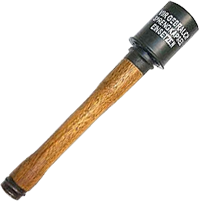Model 24 Stielhandgranate

Unlike the American Mk II A1 grenade, the Model 24 Stielhandgranate (stick hand grenade) did not rely on the damage caused by extensive metal fragmentation, but instead did its damage with a larger explosive charge.
The Stielhandgranate 24 was armed by unscrewing a cap in the base of the handle and pulling a cord which activated a friction igniter that was attached to the fuse at the base of the grenade's head.
The distinctive wooden handle allowed German soldiers to throw the Stielhandgranate 24 much further than the grenades of their Allied counterparts, and the unique design earned the nickname "potato masher."
Because of its design, the Stielhandgranate 24 could be configured in a variety of ways. By strapping multiple heads to one grenade, a small demolitions charge could be made. A device similar to a Bangalore torpedo could be created by attaching one grenade and a number of heads to a length of wood.
Notes
As is demonstrated in the film, one of the potentially dangerous aspects of using grenades—both American and German—are the variable lengths of the fuses. If a grenade is thrown too soon it is possible (if unlikely) for the enemy to throw the grenade back at its thrower. If the grenade is held too long ("cooking" the grenade), in order to prevent such a possibility, it is possible for the grenade to detonate in the thrower's hand, or to explode harmlessly in the air while on its way to its target. One effective use of a cooked grenade—an airburst—can result in the grenade exploding above its target, which is particularly deadly.
